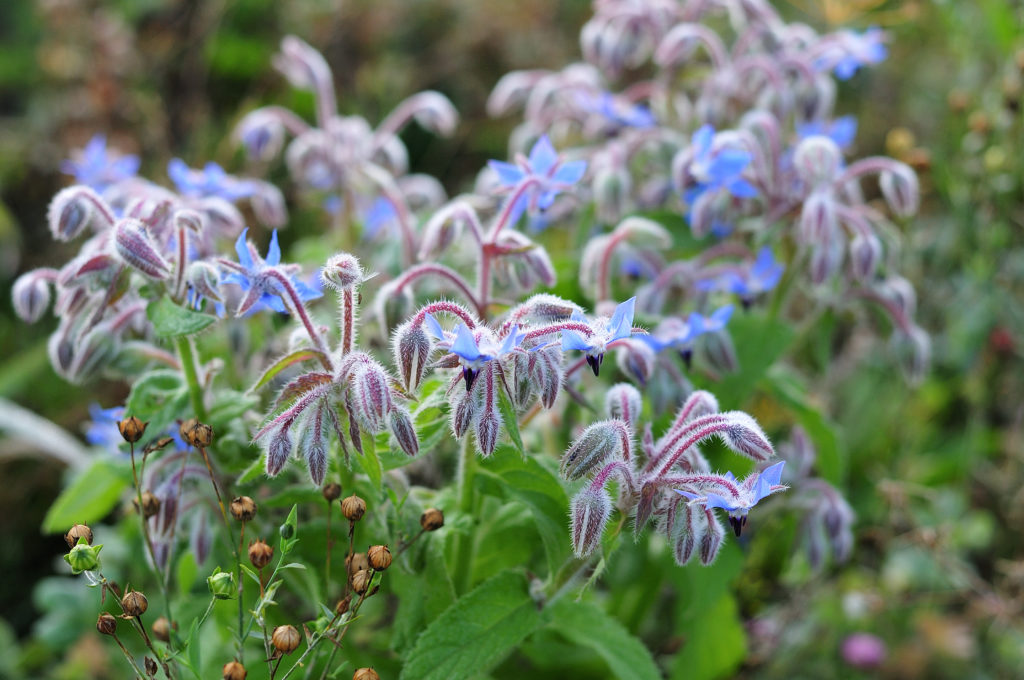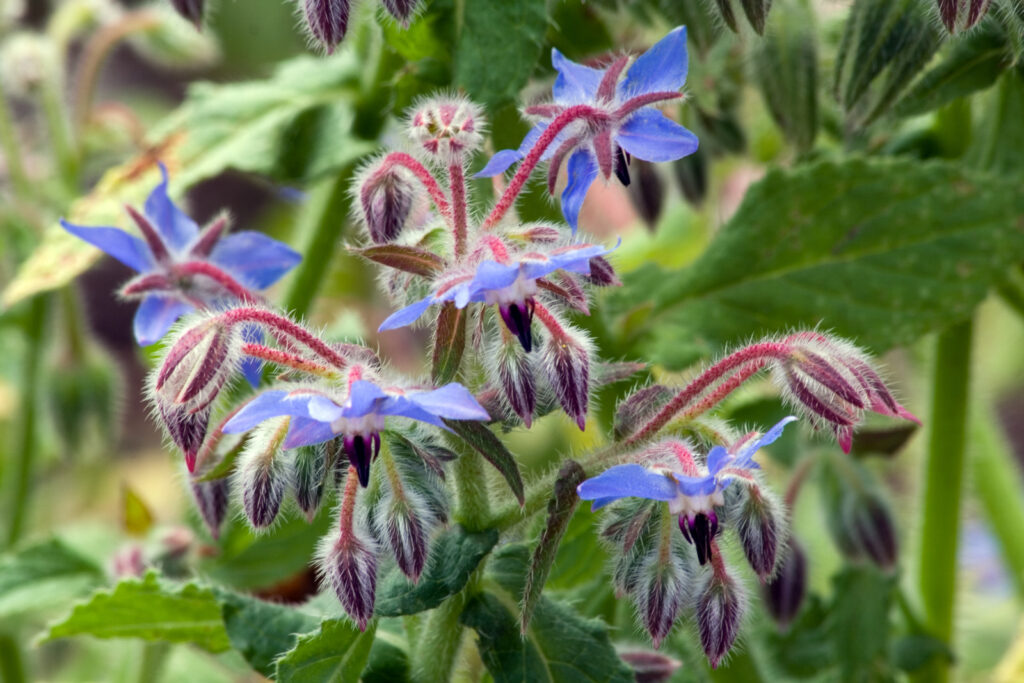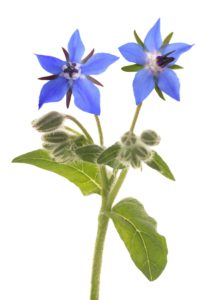You can grow borage in minutes. Borage is a decorative herb festooned in summer with clusters of intensely blue star-shaped flowers. The leaves and flowers of borage taste like cucumbers. The flowers can be floated in summer drinks and candied for decoration. The leaves can be used in salads, sandwiches, and desserts or sautéed like spinach. Borage is not a finicky herb; it will grow in most gardens as long as the soil is well-drained.
Here is your complete guide to growing borage.
Where to plant borage
- Best location: Plant borage in full sun; it will tolerate partial shade.
- Soil preparation: Grow borage in well-drained but moisture-retentive soil rich in organic matter. Add aged compost to the planting bed and turn it under to 12 inches before planting. Borage will grow in poor soil or alkaline soil as long as it is well-drained. Borage prefers a soil pH of 6.0 to 7.0.

When to plant borage
- Seed starting indoors: Borage can be started from seed indoors 6 to 8 weeks before the last frost. Start seed in biodegradable pots that can be set in the garden to avoid root disruption. Seeds germinate in 7 to 10 days.
- Transplanting to the garden: Transplant borage seedlings to the garden after the last frost in spring. Borage quickly develops a taproot so be careful when transplanting to not damage the root.
- Outdoor planting time: Sow borage seed in the garden after the average last frost date in spring when the soil has warmed. Sow seed where it will grow; borage is difficult to transplant. The seed must be covered for germination. Seeds can also be sown in the garden in the fall; seeds will germinate the following spring.
How to plant borage
- Planting depth: Sow borage seeds ¼ to ½ inch deep.
- Spacing: Thin plants from 18 to 24 inches apart once they are 6 to 8 inches tall. Space rows 18 to 24 inches apart.
- How much to plant: Grow 1 borage plant for cooking; grow 2 to 4 plants for tea or preserving.
Borage companion planting
- Companion planting: Plant borage near basil, leeks, pumpkins, kale, nasturtiums, pansies, marigolds, and parsley. Borage is said to strengthen the pest and disease resistance of plants growing nearby, particularly strawberries. Honeybees love borage. Plants will attract bees and other pollinators to your garden. Borage is said to deter cabbage worms.
Watering and feeding borage
- Watering: Borage requires even regular water until established. Once established the soil can dry out between waterings.
- Feeding: Borage does not require feeding; avoid soil rich in nitrogen or plants may not bloom. Fertilize with compost tea or a dilute solution of fish emulsion to give flowering plants a boost.
Borage care and maintenance
- Care: Keep planting beds well-weeded to avoid competition for moisture. Tall plants may require staking or support. Remove faded flowers to prolong blooming.
- Mulching: Mulch around borage to keep foliage off of the ground where it may rot.
- Pruning: Pinch back plants when 6 inches tall to encourage bushiness. You can prune back borage by one-half in midsummer; this will encourage new tender leaves for late summer harvest
Container growing borage
- Container growing: Borage grows easily in containers. Choose a container 12 inches deep and wide or larger; borage forms a taproot.
- Winter growing: Borage is an annual that will die back in freezing weather. In mild-winter regions, borage may survive the winter to flower again next summer.
Borage pests and diseases
- Pests: Japanese beetles are sometimes attracted to borage and will eat the leaves. Japanese beetles can be controlled with neem oil or excluded by covering plants with a floating row cover.
- Diseases: Borage can be susceptible to root rot in constantly wet soil otherwise it has no serious disease problems. Fungal leaf spot may occur; spray plants with compost tea to control fungal diseases.

How to harvest borage
- When to harvest: Snip fresh, young leaves in spring and summer as needed. Harvest young leaves before they develop bristly hairs. Older bristly leaves can be coarse. Flowers can be snipped individually or in clusters as soon as they open.
- How to harvest: Cut or snip leaves and flowers with a garden snip or scissors.
 Borage in the kitchen
Borage in the kitchen
- Flavor and aroma: Borage leaves and flowers have a cucumber-like flavor, cool and fresh-tasting with a slight saltiness. Add borage to any dish where you want cucumber flavor such as green salads. Use borage leaves and stems as a flavoring.
- Leaves: Use young borage leaves raw, steamed or sautéed in butter like spinach. Steamed leaves can be eaten as a vegetable. The furry coating on leaves disappears when steamed. Mince young leaves in yogurt or over soups, salads, curries, fish, and chicken dishes. Leaves and flowers enhance cheese, fish, poultry, eggs, most vegetables, green salads, ice beverages, pickles, and salad dressing. Use leaves to make flavored vinegar. Use mature leaves sparingly; they can be toxic when ingested in large quantities.
- Flowers: Add fresh borage flowers to salads or sandwiches. Flowers can be floated in drinks or candied for use on cake, ice cream, and other desserts. Freeze flowers in ice cubes or drop freshly picked flowers in drinks.
- Stems: You can eat borage stems peeled and chopped like celery.
Preserving and storing borage
- Borage leaves can be frozen or dried, but the flavor is best when leaves are used fresh.
- Refrigeration: Leaves and stems can be refrigerated for 3 to 4 days in a sealed plastic bag wrapped in a damp paper towel.
- Drying: Dry leaves and flowers in the microwave (a single layer on paper towels, microwave 1 to 3 minutes) or in the refrigerator on a baking sheet covered with paper towels. You can air-dry leaves and flowers: place them in a mesh bag and hang them in a cool, dry place or put them in an uncovered bowl and stir the leaves daily until they dry.
- Freezing: Place leaves in a plastic bag to freeze. Leaves and flowers also can be frozen in ice cubes. Drop an ice cube with a frozen borage flower inside into lemonade or other clear drinks.
Borage propagation
- Seed: Borage readily reseeds; transplant volunteers before they develop taproots. Direct sow seeds in late spring.
Borage varieties to grow
- Common borage (Borago officinalis): is the most familiar borage described above.
- Variegata (Borago officinalis ‘Variegata’): has mottled green leaves and white flowers; also known as white borage.
- Creeping borage (Borago pygmaea): a sprawling plant with fragrant, pale blue blooms that appear from late spring through early autumn.
Get to know borage
- Botanical name and family: Borago officinalis (Boraginaceae—forget-me-not family)
- Origin: Southern Europe and Western Asia
- Type of plant: Borage is a warm-season annual herb; however, sometimes flowers do not appear until the second year—making borage a sometimes biennial.
- Growing season: Summer
- Growing zones: Grow borage in zones 3 to 10.
- Hardiness: Borage tolerates heat and cool weather but will not survive a hard frost.
- Plant form and size: Borage grows 1 to 3 feet tall and wide; it is shrubby with branching stems.
- Flowers: Borage has intensely blue, star-shaped flowers that grow in drooping clusters at the tips of stems; flower buds have a silvery sparkle from ubiquitous white hairs.
- Bloom time: Borage blooms from early summer until the first frost in fall.
- Leaves: Borage has grey-green oval leaves that grow 4 to 5 inches; the leaves have a rough-textured surface covered with stiff velvety hairs.
Also of interest:
- Anise
- Anise Hyssop
- Arugula
- Basil
- Bay
- Bee Balm
- Borage
- Calendula
- Caraway
- Catnip
- Chamomile
- Chervil
- Chives
- Cilantro-Coriander
- Clary
- Costmary
- Cress
- Dill
- Fennel, Sweet
- Horseradish
- Hyssop
- Lavender
- Lemon Balm
- Lemon Verbena
- Lovage
- Marjoram
- Mint
- Nasturtium
- Oregano
- Parsley
- Perilla
- Rosemary
- Sage
- Salad Burnet
- Savory
- Scented Geranium
- Shiso
- Sorrel
- Stevia
- Sweet Cicely
- Tarragon
- Thyme
Related articles:
Best Herbs for Container Growing
Planning the Home Fruit Garden
Garden Planning Books at Amazon:
- Vegetable Garden Almanac & Planner
- Kitchen Garden Grower’s Guide Vegetable Encyclopedia
- Vegetable Garden Grower’s Guide
- Tomato Grower’s Answer Book


 Borage in the kitchen
Borage in the kitchen












